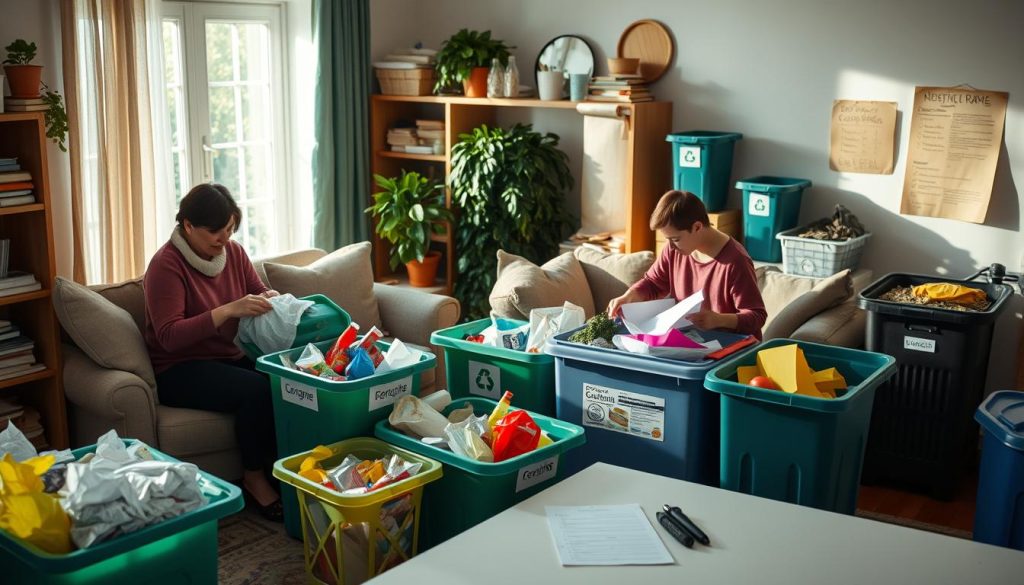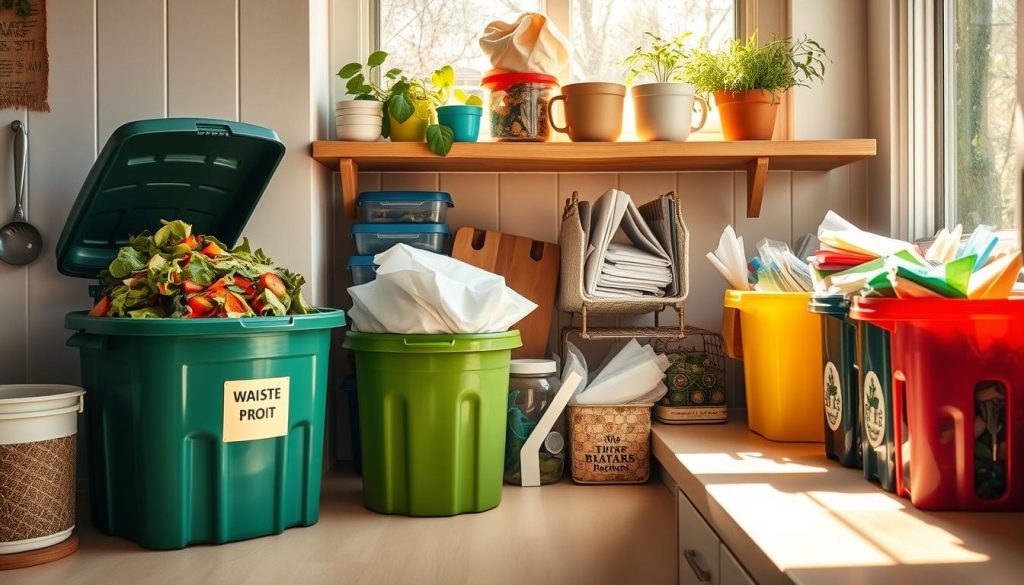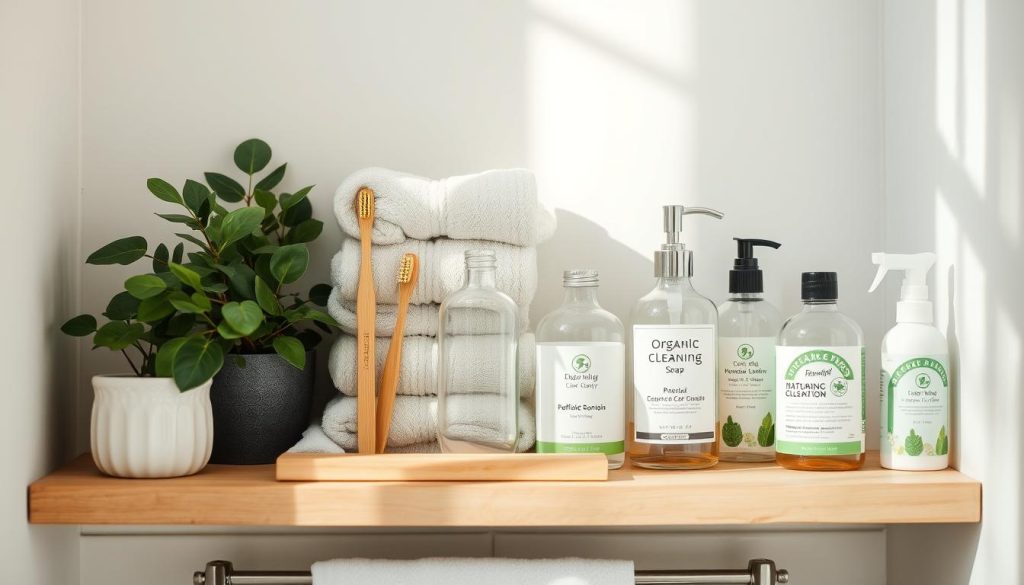I’m excited to share some practical waste reduction strategies that can make a big difference in your home. By adopting sustainable practices, we can all play a part in resource conservation and create a cleaner environment.
In this guide, I’ll walk you through simple steps to minimize waste, save money, and reduce your environmental impact. From kitchen tips to composting tricks, you’ll find plenty of ideas to kickstart your journey towards a more sustainable lifestyle.
Let’s dive in and explore how we can make our homes more eco-friendly, one small change at a time. Ready to get started? Great! Let’s make a positive impact together.
Understanding the Importance of Waste Reduction
Waste reduction is more than a trend. It’s key to a sustainable future. Let’s explore why it’s vital for our planet and our wallets.
Environmental Impact of Household Waste
Our trash doesn’t vanish when it leaves our homes. It ends up in landfills, pollutes oceans, and harms wildlife. By reducing waste, we protect our environment and natural resources. This supports the circular economy, aiming to use materials efficiently and reduce waste.
Economic Benefits of Reducing Waste
Reducing waste benefits the planet and our wallets. Buying less and reusing more saves money. Recycling also creates jobs and boosts the economy. It’s a win-win that supports zero waste goals.
Building a Sustainable Future Through Waste Minimization
Every small action can lead to big changes. By reducing waste, we move towards a sustainable future. It’s about changing habits, making smart choices, and thinking about our actions’ long-term effects. Together, we can create a world with less waste and better resource use.
- Reduce consumption
- Reuse items creatively
- Recycle properly
- Compost organic waste
By adopting these practices, we’re not just cutting waste. We’re building a better future for future generations.
Getting Started with a Home Waste Audit

A home waste audit is a key step in reducing waste. I’ll show you how to find areas to improve and set waste reduction goals.
Start by collecting your household waste for a week. Sort it into types like food scraps, plastics, paper, and electronics. Weigh each type and note the results. This data is your starting point for reducing waste.
Then, look at your findings. See if you’re wasting a lot of food or using too many plastics. This helps you know where to start reducing waste.
Set goals based on what you found. For example, try to cut food waste by 30% or use 50% less plastic. These goals will help you stay on track.
| Waste Category | Current Weight (lbs/week) | Reduction Goal (%) |
|---|---|---|
| Food Scraps | 10 | 30 |
| Plastics | 5 | 50 |
| Paper | 8 | 40 |
| Electronics | 2 | 25 |
Don’t just do a waste audit once. Do it every few months to see how you’re doing. With regular effort, you’ll make big changes in reducing waste at home.
Implementing the 3 Rs: Reduce, Reuse, Recycle

Embracing the 3 Rs is key to successful waste reduction strategies. Let’s explore how we can make a real difference in our homes and communities.
Strategies for Reducing Consumption
I start by buying only what I need. Before shopping, I make a list and stick to it. Choosing products with eco-friendly packaging helps cut down on waste. I opt for reusable items like cloth bags and water bottles. These simple steps go a long way in reducing my overall consumption.
Creative Ways to Reuse Everyday Items
Reusing items gives them new life. I turn glass jars into storage containers or vases. Old t-shirts become cleaning rags. Cardboard boxes transform into organizers. By thinking creatively, I find countless ways to repurpose items I’d otherwise throw away.
Mastering Household Recycling
Proper recycling is crucial. I sort my recyclables carefully, following local guidelines. I rinse containers before recycling and remove non-recyclable parts. Participating in community recycling initiatives helps me stay informed about best practices. By mastering these habits, I contribute to efficient recycling processes.
Remember, small changes add up. By reducing, reusing, and recycling, we each play a part in creating a more sustainable future. These waste reduction strategies not only benefit our planet but can also save us money in the long run.
Waste Reduction Strategies for Your Kitchen
The kitchen is a key area for reducing waste. By using sustainable practices, we can lessen our environmental impact. Let’s look at some ways to cut down on waste in our kitchens.
Meal planning is a big help. I plan my meals for the week to avoid buying too much. This has greatly reduced food waste at home. I also keep food fresh by storing it right. For instance, I treat herbs like flowers to keep them fresh.
Leftovers are now a breeze to handle. I get creative with them. Last night’s veggies become today’s quiche filling. Stale bread turns into crunchy croutons. These small steps help me reach my zero waste goals.
Composting has been a game-changer. I started with a small bin for fruit and veggie scraps. Now, my backyard compost pile feeds my garden. It’s incredible how much waste we can turn into nutrient-rich soil.
| Kitchen Item | Waste Reduction Strategy |
|---|---|
| Produce scraps | Compost or use in homemade stock |
| Glass jars | Repurpose for food storage or crafts |
| Plastic bags | Replace with reusable cloth bags |
| Paper towels | Switch to washable cloth napkins |
By using these sustainable practices in my kitchen, I’ve made big strides towards zero waste. It’s fulfilling to see how small actions can significantly reduce our environmental impact.
Minimizing Waste in Bathrooms and Laundry Areas

Bathrooms and laundry areas can create a lot of waste. I’ll share some ways to reduce our environmental impact in these areas. By using resource conservation techniques, we can make a big difference at home.
Eco-Friendly Personal Care Products
Choosing eco-friendly personal care items is a smart move. Using shampoo bars instead of bottled shampoo helps cut down on plastic waste. Bamboo toothbrushes and refillable soap dispensers are also easy swaps that help reduce waste.
Water Conservation Techniques
Water conservation is key in bathrooms. I’ve installed low-flow showerheads and faucet aerators to use less water without losing comfort. Fixing leaky taps and taking shorter showers are simple ways to save water.
Sustainable Laundry Practices
In the laundry room, I focus on sustainable practices. Using cold water for most washes saves energy. I’ve also switched to eco-friendly detergents and dryer balls to cut down on chemical waste and energy use. Hanging clothes to dry is another way to save resources.
| Area | Waste Reduction Strategy | Environmental Impact |
|---|---|---|
| Bathroom | Use shampoo bars | Reduces plastic waste |
| Bathroom | Install low-flow fixtures | Conserves water |
| Laundry | Wash in cold water | Saves energy |
| Laundry | Use eco-friendly detergents | Reduces chemical waste |
Tackling Paper Waste and Junk Mail
Paper waste can quickly build up at home. To fight this, I’ve started using waste minimization techniques. One good way is to go digital. I choose e-bills, online statements, and digital subscriptions over paper ones.
This approach cuts down on paper clutter and makes keeping documents simple. It’s a big help in staying organized.
Dealing with junk mail is another challenge. I’ve signed up with the Direct Marketing Association’s Mail Preference Service. This helps me avoid unwanted mail. I also reach out to companies to get my name off their lists.
These steps have greatly reduced the junk mail I get. It’s a big win for my home.
When paper does arrive, I have a plan:
- I recycle anything I don’t need right away
- I shred important documents for safety
- I use scrap paper for notes or lists
- I compost certain paper products
By using these methods, I’ve cut my paper waste by more than half. It shows how small changes can have a big effect. The secret is to keep up with these habits.
Composting: Turning Kitchen Scraps into Garden Gold
Composting is a big win for the environment and for your garden. It’s a great way to cut down on waste and make your soil better. I’ve seen it work wonders in my own garden.
Setting Up a Composting System
Starting a compost pile is easy. I began with a simple bin in my backyard. You can buy one or make your own from wood pallets. The trick is to mix green materials (like fruit peels) with brown ones (like dry leaves).
What to Compost and What to Avoid
Most kitchen scraps are good for composting. I add fruit and veggie peels, coffee grounds, and eggshells. Yard waste like grass clippings is also great. But, meat, dairy, and oily foods are a no-go because they attract pests and smell bad.
| Compostable | Not Compostable |
|---|---|
| Fruit and vegetable scraps | Meat and fish |
| Coffee grounds and filters | Dairy products |
| Eggshells | Oily foods |
| Yard trimmings | Pet waste |
Using Compost in Your Garden
When my compost is dark and crumbly, it’s time to use it. I mix it into my garden soil to add nutrients or use it as a top dressing. It’s incredible how compost can turn waste into something valuable for your garden. It’s all about reducing waste and living sustainably.
Embracing a Zero Waste Lifestyle: Tips and Tricks
Adopting a zero waste lifestyle is a great way to help reduce waste and support a circular economy. By making small changes in our daily lives, we can reach our ambitious zero waste goals.
One of my favorite tips is to carry reusable bags, containers, and water bottles with me. This simple act cuts down on single-use plastics and makes me more aware of what I consume. I also shop at bulk stores, filling my own containers with what I need, which reduces packaging waste.
In my kitchen, I plan meals and compost. These habits have greatly reduced my food waste and made nutrient-rich soil for my garden. For personal care, I’ve switched to bar soaps, shampoos, and toothpaste tablets, getting rid of plastic packaging in my bathroom.
- Choose products with minimal or recyclable packaging
- Repair items instead of replacing them
- Donate or sell items you no longer need
- Use cloth napkins and towels instead of paper
By using these waste reduction strategies, I’m getting closer to my zero waste goals and supporting a circular economy. Every small action we take can make a big difference in reducing waste and protecting our environment.
Community Initiatives and Resources for Waste Reduction
Working together with my neighbors has really helped in reducing waste. Our community has recycling programs that go beyond just curbside pickup. We have special events for electronics, hazardous materials, and yard waste.
These events make it easy to get rid of hard-to-dispose items the right way. It’s a big help for everyone.
Composting is also becoming more popular. Some cities offer communal compost bins or discounted kits for home use. I’ve seen how food scraps turn into soil for community gardens.
This is great for the environment and local gardens. It shows how waste reduction can benefit everyone.
Local libraries and community centers also offer workshops on living green. I’ve learned about zero-waste cooking, making DIY cleaning products, and upcycling furniture. These workshops have been super helpful.
By using these resources, I’ve not only changed my own habits. I’ve also met others who care about a cleaner planet. It’s a win-win for all of us.

